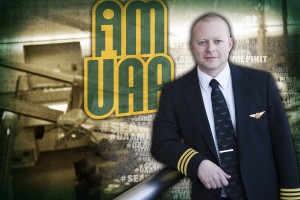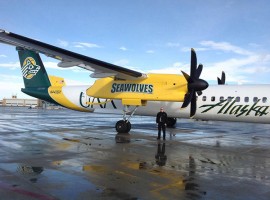Alumni Spotlight: Tony Barton
by Tracy Kalytiak |
B.S. Aviation Technology '09 Hometown: Spokane, Wash. Fun Fact: Tony loves snowboarding.

Tony Barton earned a bachelor's degree through UAA's Aviation Technology program and now is a Horizon Air pilot. Photo by Philip Hall/University of Alaska Anchorage.
"Top Gun" transformed Tony Barton's life. He first saw the iconic fighter-pilot movie at age 7 and watched it as often as he could, dreaming of nestling into a cockpit and ripping through the air high above snow-padded ridges and silvery seams of rivers.
A couple of VHS "Top Gun" tapes later, Tony finished high school in his hometown of Spokane, Wash. His eyesight wasn't perfect, so the Air Force wouldn't take him as a prospective pilot. "At the time, Lasik was not around," he said. "I always wanted to fly, but didn't know how to get into it."
Tony painted hot rods until inspiration struck as he and his fiancée rode a chairlift. "I was pretty tired of painting cars," he said. "I told her I'd like to quit work, learn to fly. I was thinking I wanted to go to Alaska. What better place to go? Enough said!"
Tony discovered UAA offered an Aviation Technology degree and enrolled.
"We got married, went to Jamaica and moved up," he said. That was in 2004. Tony graduated in 2009, instructed other fledgling pilots for two years, flew with Era Aviation and now pilots planes for Horizon Air.
"My wife, Wendy, and I had our two sons here and moved back to Spokane to be close to grandparents, in 2011," Tony said. "The job with Horizon got us home. It's a great company, has a great union and people, and the airplanes are the most advanced. They pay to put the technology in there."
Even though Tony lives in Spokane, he actively participates in the UAA Aviation Alumni chapter. "Hopefully this year we'll get that going full force," he said. "We want to cover the whole program, not just piloting, and launch a website." The chapter recently launched a Facebook page, https://www.facebook.com/UAAAviationAlumni.
Launching into a new career
Tony couldn't wait to explore and start making connections, back when he first arrived in Alaska to begin his UAA classes.
"I just thought Alaska would be the coolest terrain, weather, all conditions, glaciers, wildlife, lots of places you can only get by air," he said. "It's tight-knit. Start networking and soon everyone knows you."
UAA offers four programs at its 80,000-square-foot Merrill Field facility: air-traffic control, aviation maintenance, professional piloting and aviation management, said Director and Associate Professor Rocky Kapozzi. Students may earn bachelor's or associate degrees in professional piloting, air-traffic control and aviation management and certificates or associate degrees in aviation maintenance-airframe or powerplant mechanics.
UAA trains its students in four Diamond DA-20 aircraft, three Cessna 172-SPs, two Cessna 172-RGs and one PA-30 Piper Twin Comanche.
"One of the great things about UAA is the really awesome technology in their airplanes," Tony said. "The 172RG has a glass cockpit in it. There's lots of information presented on those screens."
Flight seems effortless, but aviation is an intricate subject to grasp, Tony said. Aspiring pilots take classes at UAA's facility and then learn how to take off, land and recover from stalls, moving through progressively more difficult challenges until they are able to solo, fly cross country and then fly cross country solo.
Tony hadn't studied math for a few years and felt a little nervous.
"I'm OCD, I like to do good in school," Tony said. "If you don't use math, it's gone. I didn't know anything about aviation. I was a little scared. I went to my first flight lesson preflight training. When you get in there and start the engine, it's real."
In his training, Tony learned to use visual flight rules (VFR) sectional charts that provide pilots a detailed layout of the terrain they'll be flying over-"even the littlest lakes are on there"-and "lat-longs," points defined by latitude and longitude that can be used to define a route on a flight plan.
He also learned how to find his way using pilotage-referring to landmarks-and dead reckoning, which involves using a watch or clock, airspeed indicator, compass and accurate estimates of wind speed and wind direction to keep track of time and the rate and direction of travel.
Tony uses an "old-school mechanical calculator"-an E6B flight computer-that enables him to spin wheels, draw circles and use a time ring, pointers and scales to figure out how many gallons of fuel and how much time in the air he has left.
"You learn a lot of principles on the ground, but it doesn't click until you're in the air," he said. "Each time you go up, you're doing something new, so it's always challenging."
Turbulence? How do you handle that? Reduced visibility in snow or rain? What do you do? Mountains in the area? What's the proper way to fly above or between them?
"A day like this goes to fog like that," Tony said, snapping his fingers. "You've got to learn weather, pick up on the trends. The most difficult thing to learn is landing. You either hear, 'Nice landing!' or 'Wow, we're here!' I always strive for the first one. Aviation is a pretty complex thing to learn."
And it remained complex, even after Tony earned his degree and began instructing others entering the Aviation Technology program.
"You have to project that knowledge, know it-not just rote-and be able to explain it in different ways," Tony said. "Going from student to teacher, it's a huge transition. As a pilot, when you instruct, you learn more than you would ever without. There's things students will do in an airplane, unexpected things, so you learn to stay on your toes. You have to know the absolute limits of the airplane."
His favorite class at UAA was Alaska bush flying, an advanced class where he learned off-airport techniques like landing on gravel bars on rivers.
Setting down roots...in the air
Tony now flies Horizon routes in the Lower 48, primarily in Bombardier Q400 aircraft; one of Horizon's Q400 turboprop craft, tail number N443QX, features UAA Seawolf colors and logo.

UAA alumnus Tony Barton is a pilot for Horizon Air, which owns this Q400 turboprop painted with Seawolves' colors and logo. Photo by Mike Jaeger.
On his trips, which can involve flying between places as distant from each other as Los Angeles and Laredo, Mexico, Tony brings along clothes and packs fresh fruit, vegetables, "a couple of giant salads," and sandwiches, as well as pilot staple foods like Clif bars, trail mix, tuna in a packet.
He's lived outside Alaska for three years yet still loves the beauty he discovered on his flights throughout the Last Frontier, in places like Homer, Ketchikan, Cordova, Barter Island: "You'll see polar bears, sometimes with fresh kills, that stick around the airport there."
What are the most hair-raising Alaska airports to land in? Tony bestows the honor on both Valdez and Point Hope.
"Valdez is at the end of an inlet, sea level to 6,000 feet all around you," he said. "The winds can just scream there. It's a white-knuckle ride. And Point Hope, if you look at it on a map, is essentially this point of land that comes deep enough for whales to cut the corner there. You can see whalebones, and whales surfacing. The runway at Point Hope is pretty short. You land, you don't mess around-you don't want to end up in the drink."
Tony has taken his two sons-5-year-old Jayden and 2-year-old Josh-on plane rides. Jayden prefers trains, backhoes and loves to sit in planes. Josh, however, seems to share his father's passion for flying.
The VHS tapes are relics of the past, but Tony still watches "Top Gun"-on Blu-ray.
"If you're into adrenaline, you're hooked as soon as you add power on that first takeoff roll," Tony said. "You lift off, and there you are."
Written by Tracy Kalytiak, UAA Office of University of Advancement
 "Alumni Spotlight: Tony Barton" is licensed under a Creative Commons Attribution-NonCommercial 4.0 International License.
"Alumni Spotlight: Tony Barton" is licensed under a Creative Commons Attribution-NonCommercial 4.0 International License.














